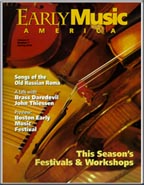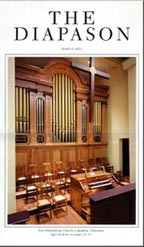|
Complete Seventeenth-Century French Unmeasured Preludes Nanette G. Lunde, harpsichord Sparrow CD 101 (2 discs) 64:25 mins; 54:26 mins. Nanette G. Lunde has produced a cauliflowered-sized diamond of a recording. Complete Seventeenth-Century French Unmeasured Preludes, with two discs and nearly seventy individual pieces, is as vast and unwieldy as the title suggests. Yet the playing is so satisfying, the instrument's tone so clear, and the engineering so outstanding that I find the release to be among the very best recent recordings of solo harpsichord. The reason for this project, the neglected unmeasured prelude (a modern label-the works were originally simply preludes) is to these ears a close cousin of the toccata and the fantasy. These preludes wander between the composed and the improvised, and constantly and gracefully change key, motif, and apparent measure. It is this mutability that causes the listener to be engaged by, and ultimately lost in, the expansive two hours of music. I would have been grateful for an interlude of strictly measured music. -Kate Grossman |
 |
|||||||||||||||
|
|
|||||||||||||||||
|
 |
Harpsichord News Nanette G. Lunde's two-disc set comprising all the known 17th-century French unmeasured preludes for harpsichord is also a distinguished addition to the harpsichord discography. Beginning with sixteen ''white-note'' preludes of Louis Couperin, she continues with the multiple pieces in this style by Nicolas Lebègue, Elisabeth-Claude Jacquet de la Guerre, Jean Henry d'Anglebert, Louis-Nicolas Clérambault, Gaspard Le Roux, and unique examples from the pens of Marchand, Rameau, Siret, and Michel (?) Forqueray. Twenty-nine anonymous preludes from widely-dispersed manuscripts complete this comprehensive project. Lunde plays with style, conviction, and, above all musicality in this often problem-plagued repertoire. Her solutions for organizing the improvisatory works are sensible, her artistry subtle, and the sounds from her 1988 Willard Martin harpsichord (after a Blanchet instrument of 1720), appropriate. Tuning in l/4-comma meantone temperament and her choice of a low 'French opera' pitch (A=392) allow these works to sound both pungent and dark-hued. A suggestion to listeners: approach these discs as you would a large selection of appetizers from a gourmet menu! Too many at one time could lead to aural distress. The preludes were intended to preface dance movements or to test tunings. Use them as introductions to other, more rhythmically-structured works; savor the preludes one or two at a time, thus avoiding an overdose. -Larry Palmer |
|||||||||||||||
